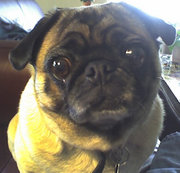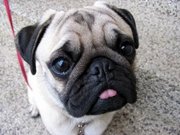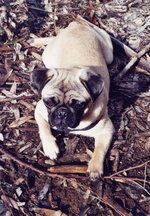Mops
|
From Wikipedia the free encyclopedia, by MultiMedia |
| Pug | ||
|---|---|---|
| Alternative names | ||
| Carlin Mops |
||
| Country of origin | ||
| China, perhaps Korea | ||
| Common nicknames | ||
| Classification and breed standards | ||
| FCI: | Group 9 Section 11 #253 | |
| AKC: | Toy | |
| ANKC: | Group 1 (Toys) | |
| CKC: | Group 5 - Toys | |
| KC (UK): | Toy | |
| NZKC: | Toy | |
| UKC: | Companion Breeds | |
| Not recognized by any major kennel club | ||
| This breed of Dog is extinct | ||
| Notes | ||
The Pug is a small but robust toy Dog breed with a compressed, wrinkly face.
The Pug's appearance is characterized by a flat, wrinkled face, compact body, and curled tail. Pugs have four color variations: fawn with a black mask and ears, entirely black, silver, or apricot. The silver or apricot-fawn colors should be decided so as to make the contrast complete between the color and the trace and the mask. The breed generally stands between 10 and 11 inches (25–28 cm) tall at the withers with an ideal weight range of 14 to 18 lb (6.3 to 8.1 kg). However, current AKC judges indicate slightly larger Pugs as higher quality. "Fawn" is the most common Pug color, black is rare, and silver is very rare. Most fawn Pugs have black facial features.
While Pugs do not bark much, they are still quite noisy. Many Pugs make a grunting nasal noise, which increases when they get excited. Some may snore, especially if overweight.
 A Pug's nose is mashed in and is responsible for snoring and snorting
A Pug's nose is mashed in and is responsible for snoring and snorting
The Pug is a very sociable Dog, but quite stubborn. The breed even has its own motto associated with it: "multum in parvo" (a lot in a little). The Pug is a popular breed for a housepet, as it is easy to groom (though it sheds substantially more than other Dogs of similar size). Pugs are true "lap Dogs", in that they most often want nothing more than to curl up in their owner's lap (and perhaps a snack). They require regular exercise, and some Pugs will walk for an hour or more. When exercising a Pug, however, it is important to make sure they do not overheat, as their short noses do not cool them off as easily as those of longer-nosed breeds. Pugs are generally compatible with most children and other animals.
Pugs are not noted for high achievement in obedience competitions, although, like all Dog breeds, they are intelligent and learn quickly in the right environment. According to the book The Intelligence of Dogs, they have only fair ability to learn new commands and to obey commands the first time. On the other hand, it is worth noting that there is much debate about how to accurately measure Dog intelligence.
Unlike many other breeds, Pugs have not been bred for physical attributes, but rather have been bred for human companionship. In other words, Pugs have been bred to have amiable dispositions, and to enjoy being with humans.
 Part of the Pug's appeal is the wrinkled, expressive face.
Part of the Pug's appeal is the wrinkled, expressive face.
Because they have extremely short snouts and no skeletal brow ridges, Pugs can easily scratch their corneas or puncture their eyeballs. Their short noses can also cause them to develop breathing problems. They are also prone to skin infections if the crevices in their faces are not kept clean. Additionally, Pugs may be prone to skin allergies, which if not treated can lead to infection as the Pug scratches the inflamed areas. The breed's characteristic flat face may also contribute to tooth and mouth problems. Pugs typically love to eat, and so are prone to obesity; they can quickly reach unhealthy weights. It is therefore important for Pug owners to make sure their pets get regular exercise. Due to their short snouts, Pugs are vulnerable to temperature extremes. It is important to make sure that they do not overheat in hot weather, and likewise they should not be left outside in very cold weather.
Pugs can also suffer from a chronic form of Granulomatous Meningoencephalitis (an inflammation of the brain) specific to the breed called Pug Dog Encephalitis (PDE). PDE is estimated to occur in 1% of Pugs. There is no known cause or cure for PDE, although it is believed to be an inherited disease. [1]. PDE is invariably fatal. All Dogs either die or are put to sleep within a few months after the onset of clinical signs. [2].
A healthy Pug can be expected to live 10 to 13 years, although many well cared for Pugs have reached 18.
History
 The demeanor of a Pug ranges from expressive and playful to calm and warm.
The demeanor of a Pug ranges from expressive and playful to calm and warm.
Most agree that the Pug originated in China, dating back to around 700 BC, though there is some debate as to the breed it was derived from, perhaps from Korea. It was bred to be a companion Dog, rather than a guardian. Pugs were kept by the royalty and were pampered and spoiled, and the expectation of such treatment is a characteristic that seems to remain with them to this day. Sometimes, as a mark of great esteem, Pugs were given to members of the court.
Some interesting anecdotal history (not officially verified, but worth mentioning) includes an ancient Chinese law whereby only the Emperor was allowed to own a Pug. According to these anecdotes, a person could be put to death for owning a Pug, unless it was given to him by the Emperor himself.
When the Dutch started trading with China, sailors smuggled some Pugs home to Europe, where the small Dogs and natural companions quickly became popular. Like in China, they soon became associated with nobility.
According to legend, during a campaign against the Spanish by Prince of Orange, William The Silent, his Pug, Pompey, thearted an assassination attempt. One night at Hermigny, while the prince slept, assassins crept toward his tent. Pompey heard them and began barking and scratching to warn his master, finally jumping on his master's face to alert him to the impending danger. [3]
References
Miscellaneous
Famous Pugs
Pugs in the arts
Trivia
External links
|